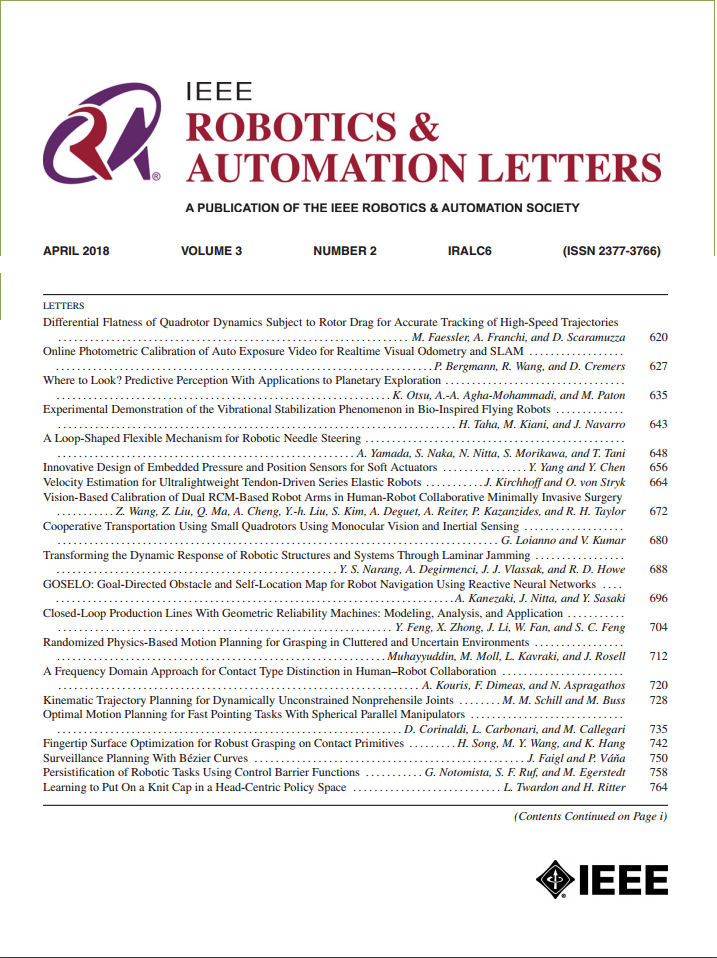RUSH:大尺度环境下基于区域视点生成的快速无人机空间分层探索
IF 5.3
2区 计算机科学
Q2 ROBOTICS
引用次数: 0
摘要
利用无人驾驶飞行器(uav)快速、自主地探索大规模环境仍然是一个挑战。远程回溯和无人机的低速飞行这两个主要问题严重阻碍了勘探效率。为了解决这一问题,我们提出了一种结合快速区域视点生成的空间分层探索方法。这涉及到使用在线hgrid空间分解将探索空间划分为子区域,并通过求解非封闭旅行推销员问题确定这些子区域的探索顺序。基于与边界相关的全局损失函数,从这些子区域中选择最佳视点。通过将空间划分为子区域并对路径进行全局优化,可以减小无人机的回溯距离。此外,选择的最佳视点允许无人机进行更小的转弯,避开障碍物,并实现更好的覆盖,这有助于减少低速运动和回溯的发生。我们还结合了速度损失约束来改善局部轨迹,确保高速飞行。我们提出的方法已经通过模拟和实际测试进行了分析和验证,与几种领先的方法相比,特别是在大规模环境中,勘探效率更高。本文章由计算机程序翻译,如有差异,请以英文原文为准。
RUSH: Rapid UAV Spatial Hierarchical Exploration via Regional Viewpoint Generation for Large-Scale Environments
Exploring large-scale environments quickly and autonomously using uncrewed aerial vehicles (UAVs) remains a challenge. Two major issues, long-distance back-tracking and the UAV's low-velocity flight, significantly hinder exploration efficiency. To tackle this problem, we propose a spatial hierarchical exploration method combining rapid regional viewpoint generation. This involves dividing the exploration space into subregions using an online hgrid spatial decomposition, and determining the order of exploration for these subregions by solving a non-closed traveling salesman problem. Optimal viewpoints are chosen from these subregions based on a global loss function related to frontiers. By dividing the space into subregions and optimizing the path globally, we can reduce the UAV's back-tracking distance. Additionally, the selected optimal viewpoints allow UAVs to make smaller turns, avoid obstacles, and achieve better coverage, which helps decrease the occurrence of low-velocity movements and back-tracking. We also incorporate a velocity loss constrain to improve local trajectories, ensuring high-velocity flight. Our proposed method has been analyzed and validated through simulations and real-world tests, showing improved exploration efficiency compared to several leading methods, particularly in large-scale environments.
求助全文
通过发布文献求助,成功后即可免费获取论文全文。
去求助
来源期刊

IEEE Robotics and Automation Letters
Computer Science-Computer Science Applications
CiteScore
9.60
自引率
15.40%
发文量
1428
期刊介绍:
The scope of this journal is to publish peer-reviewed articles that provide a timely and concise account of innovative research ideas and application results, reporting significant theoretical findings and application case studies in areas of robotics and automation.
 求助内容:
求助内容: 应助结果提醒方式:
应助结果提醒方式:


